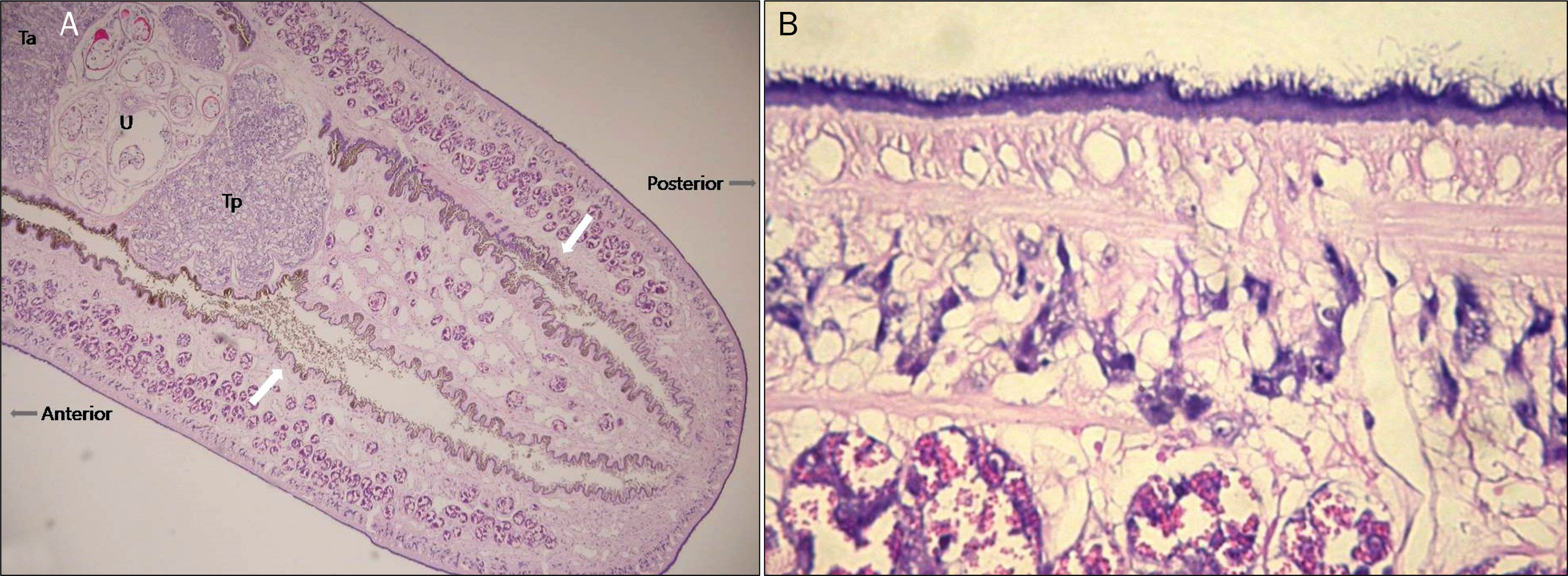Korean J Gastroenterol.
2017 Mar;69(3):177-180. 10.4166/kjg.2017.69.3.177.
A Case of Endoscopically Treated Laryngopharyngitis Resulting from Clinostomum complanatum Infection
- Affiliations
-
- 1Dr. Seo's Internal Medicine Clinic, Gwangju, Korea.
- 2Department of Internal Medicine, Kwangju Christian Hospital, Gwangju, Korea. kch20113@hanmail.net
- 3Department of Parasitology, College of Medicine, Seonam University, Gwangju, Korea.
- 4Department of Internal Medicine, Gwangju Good Morning Hospital, Gwangju, Korea.
- 5Department of Pathology, Kwangju Christian Hospital, Gwangju, Korea.
- KMID: 2383411
- DOI: http://doi.org/10.4166/kjg.2017.69.3.177
Abstract
- A 46-year-old woman visited our hospital presenting throat pain and globus sensation. The symptoms occurred seven days after eating raw perch and mullet. An endoscopy under sedation showed a fluke"•with an approximate length of 4.8 mm and width of 1.5 mm"•on the left aryepiglottic fold, with active motility on the mucosa. It was extracted from the larynx using biopsy forceps and was identified as Clinostomum complanatum. To the best of our knowledge, this is the second reported case of human infection with Clinostomum complanatum diagnosed and treated by an endoscopy in Korea. Endoscopy is a useful tool in the diagnosis and treatment of patients at risk for parasitic infections complaining of throat pain.
MeSH Terms
Figure
Reference
-
References
1. Aohagi Y, Shibahara T, Machida N, Yamaga Y, Kagota K, Hayashi T. Natural infections of Clinostomum complanatum (Trematoda: Clinostomatidae) in wild herons and egrets, Tottori Prefecture, Japan. J Wildl Dis. 1992; 28:470–471.
Article2. Yamashita J. Clinostomum complanatum, a trematode parasite new to man. Annot Zool Japan. 1938; 17:563–566.3. Hara H, Miyauchi Y, Tahara S, Yamashita H. Human laryngitis caused by Clinostomum complanatum. Nagoya J Med Sci. 2014; 76:181–185.4. Chung DI, Moon CH, Kong HH, Choi DW, Lim DK. The first human case of Clinostomum complanatum (Trematoda: Clinostomidae) infection in Korea. Korean J Parasitol. 1995; 33:219–223.
Article5. Park CW, Kim JS, Joo HS, Kim J. A human case of Clinostomum complanatum infection in Korea. Korean J Parasitol. 2009; 47:401–404.
Article6. Jung SC, Oh HJ, Kim DM, Park JH. A case of pharyngitis caused by Clinostomum complanatum. Korean J Otorhinolaryngol-Head Neck Surg. 2015; 58:61–63.7. Sohn WM, Na BK, Cho SH, Lee SW, Choi SB, Seok WS. Trematode metacercariae in freshwater fish from Water Systems of Hantangang and Imjingang in Republic of Korea. Korean J Parasitol. 2015; 53:289–298.
Article8. Chung DI, Kong HH, Moon CH. Demonstration of the second intermediate hosts of Clinostomum complanatum in Korea. Korean J Parasitol. 1995; 33:305–312.
Article9. Chai JY. Fish-borne parasitic diseases. Hanyang Med Rev. 2010; 30:223–231.
Article10. Kitagawa N, Oda M, Totoki T, Washizaki S, Oda M, Kifune T. Lidocaine spray used to capture a live Clinostomum parasite causing human laryngitis. Am J Otolaryngol. 2003; 24:341–343.
Article11. Choi JH, Kim EJ, Kim DM, Park SH, Kim SW. A case of anisakiasis invading the oropharynx. Korean J Otorhinolaryngol-Head Neck Surg. 2015; 58:61–63.
Article12. Lee EJ, Kim YC, Jeong HG, Lee OJ. The mucosal changes and influencing factors in upper gastrointestinal anisakiasis: analysis of 141 cases. Korean J Gastroenterol. 2009; 53:90–97.
- Full Text Links
- Actions
-
Cited
- CITED
-
- Close
- Share
- Similar articles
-
- A Case of Pharyngitis Caused by Clinostomum complanatum
- A Case of Unexpected Clinostomum complanatum Infection Initially Presenting as Foreign Body in Pharynx
- The first human case of Clinostomum complanatum (Trematoda: Clinostomidae) infection in Korea
- Demonstration of the second intermediate hosts of Clinostomum complanatum in Korea
- A Human Case of Clinostomum complanatum Infection in Korea



